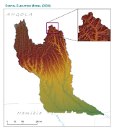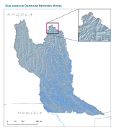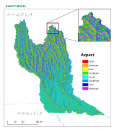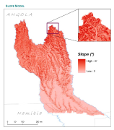CORB-contributing area
Type of resources
Available actions
Topics
Keywords
Contact for the resource
Provided by
Representation types
Update frequencies
status
Scale
-

This raster layer (90m resolution) represents streams in the CORB-Contributing area. This layer was created by interpolating the Flow Accumulation raster. All cells in the input Flow Accumulation grid that have values greater than a defined threshold have a value of “1†for Stream Definition. This dataset is part of the GIS Database for the Environment Protection and Sustainable Management of the Okavango River Basin project (EPSMO). Detailed information on the database can be found in the “GIS Database for the EPSMO Project†document produced by Luis Veríssimo (FAO consultant) in July 2009, and here available for download.
-

This vector layer (polygon) - reference scale 1/200 000 - also identifies the catchment area for each stream segment in the CORB-Contributing area. The value for each polygon corresponds to the value carried by the stream segment that drains that area, defined in the Stream Segmentation grid. Source: This layer was created by converting the Catchment Grid raster layer into vector format. This dataset is part of the GIS Database for the Environment Protection and Sustainable Management of the Okavango River Basin project (EPSMO). Detailed information on the database can be found in the “GIS Database for the EPSMO Project†document produced by Luis Veríssimo (FAO consultant) in July 2009, and here available for download.
-

This raster layer represents the Digital Elevation Model (DEM) of the CORB-Contributing area, in the reference scale of 1/200 000. It was created by converting raw SRTM data into a finalized raster layer for the CORB-Contributing area with 90m pixel resolution. This dataset is part of the GIS Database for the Environment Protection and Sustainable Management of the Okavango River Basin project (EPSMO). Detailed information on the database can be found in the “GIS Database for the EPSMO Project†document produced by Luis Veríssimo (FAO consultant) in July 2009, and here available for download.
-

This vector layer (line) – reference scale 1/200 000 – is a infered sub-surface drainage network model of the CORB-Contributing area. In the attributes table, each drainage line is linked to the micro catchment in which it resides. The creation of this layer was achieved by filtering the Drainage Network model with the Surface Drainage Network model. This dataset is part of the GIS Database for the Environment Protection and Sustainable Management of the Okavango River Basin project (EPSMO). Detailed information on the database can be found in the “GIS Database for the EPSMO Project†document produced by Luis Veríssimo (FAO consultant) in July 2009, and here available for download.
-

This raster layer represents the aspect model of the CORB-Contributing area, in the reference scale of 1/200 000. Aspect is the direction that a slope faces. It identifies the steepest downslope direction at a location on a surface. Source: The creation of this layer was achieved by interpolating the DTM raster layer. This dataset is part of the GIS Database for the Environment Protection and Sustainable Management of the Okavango River Basin project (EPSMO). Detailed information on the database can be found in the “GIS Database for the EPSMO Project†document produced by Luis Veríssimo (FAO consultant) in July 2009, and here available for download.
-

This vector layer (point) represents the points at which stream segments intersect in the CORB-Contributing area, and can aid in the identified of locations for potential hydrological monitoring. This was created by an interpolation of all stream intersections in the Drainage Line layer. This dataset is part of the GIS Database for the Environment Protection and Sustainable Management of the Okavango River Basin project (EPSMO). Detailed information on the database can be found in the “GIS Database for the EPSMO Project†document produced by Luis Veríssimo (FAO consultant) in July 2009, and here available for download.
-

This vector layer (polygon) – reference scale 1/200 000 – is a sub-basin delineation of the CORB-Contributing area, incorporating basins of the main tributaries and sub- tributaries of the Kubango/Okavango river. It was created by a supervised aggregation of micro basin units from the Catchment MicroBasins layer. This dataset is part of the GIS Database for the Environment Protection and Sustainable Management of the Okavango River Basin project (EPSMO). Detailed information on the database can be found in the “GIS Database for the EPSMO Project†document produced by Luis Veríssimo (FAO consultant) in July 2009, and here available for download.
-

This raster layer represents the slope model of the CORB-Contributing area, in the reference scale of 1/200 000. The creation of this layer was achieved by interpolating the DTM raster layer. Units are organized by degrees. This dataset is part of the GIS Database for the Environment Protection and Sustainable Management of the Okavango River Basin project (EPSMO). Detailed information on the database can be found in the “GIS Database for the EPSMO Project†document produced by Luis Veríssimo (FAO consultant) in July 2009, and here available for download.
-

This vector layer (polygon) – reference scale 1/200 000 – is an aggregated sub-basin delineation of the CORB-Contributing area,incorporating basins of the main tributaries only. It was created by aggregation of the sub basin units from the Sub Basins Level III. This dataset is part of the GIS Database for the Environment Protection and Sustainable Management of the Okavango River Basin project (EPSMO). Detailed information on the database can be found in the “GIS Database for the EPSMO Project†document produced by Luis Veríssimo (FAO consultant) in July 2009, and here available for download.
-

This raster layer (90m resolution) represents the flow accumulation in the CORB-Contributing area. This raster was created by interpolating the Flow Direction raster grid to discern the accumulated number of cells with flow direction upstream of a cell, for each cell in the input grid. This dataset is part of the GIS Database for the Environment Protection and Sustainable Management of the Okavango River Basin project (EPSMO). Detailed information on the database can be found in the “GIS Database for the EPSMO Project†document produced by Luis Veríssimo (FAO consultant) in July 2009, and here available for download.
 FAO Map Catalog
FAO Map Catalog